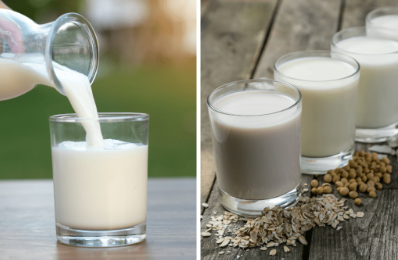Uncover the surprising truths about almond milk and dairy. Learn about their nutritional differences, environmental impacts, and the hidden facts behind these popular beverages.
Almond milk vs. dairy
The dairy aisle has transformed. What was once a simple choice between whole, skim, or 2% milk is now a complex decision involving a plethora of plant-based alternatives, with almond milk leading the charge. You might think you know the clear-cut differences, but the reality is more nuanced. Both almond milk and dairy have their pros and cons, and neither is quite the health or environmental paragon they’re often portrayed to be. This article aims to debunk common myths, explore the true nutritional profiles, and reveal the hidden facts about these popular beverages.
Unpacking the Nutritional Differences
At first glance, almond milk and dairy seem worlds apart. Dairy is often touted as a complete source of protein and calcium, while almond milk is marketed as a low-calorie, plant-based option. However, a deeper dive reveals significant variations.
- Protein:
- Dairy milk is rich in protein, typically providing around 8 grams per cup. This protein is complete, meaning it contains all nine essential amino acids.
- Almond milk, on the other hand, is notoriously low in protein, usually containing only about 1 gram per cup. This protein is also incomplete.
- Calcium:
- Dairy milk is a natural source of calcium, crucial for bone health.
- Most commercial almond milk is fortified with calcium to match dairy’s levels. However, the bioavailability of this added calcium can vary.
- Vitamins and Minerals:
- Dairy milk naturally contains vitamins like B12 and riboflavin.
- Almond milk is often fortified with vitamins like vitamin D and E, but its natural vitamin content is minimal.
- Fat and Calories:
- Dairy milk’s fat and calorie content varies depending on the type (whole, skim, etc.).
- Unsweetened almond milk is generally low in calories and fat, but sweetened versions can contain added sugars.
- Added Sugars and Thickeners:
- Many almond milks contain added sugars, and thickeners like carrageenan, or gellan gum. These added ingredients can have negative health implications.

“The perception that almond milk is inherently healthier than dairy is a common misconception,” says Dr. Anya Sharma, a registered dietitian specializing in plant-based nutrition. “While almond milk can be a suitable alternative for those with lactose intolerance or dairy allergies, it’s essential to consider its nutritional limitations.” Also Read>>>
A 2023 study published in the Journal of Food Science and Technology analyzed the nutritional profiles of various plant-based milk alternatives, including almond milk, and found significant variations in nutrient content and bioavailability.
“Here’s the thing: reading the nutrition label is crucial,” says Professor Ben Carter, a food scientist at the University of Reading. “Not all almond milks are created equal, and some contain added sugars and ingredients that can negate their perceived health benefits.” For more information on food nutrition labeling, you can review the wikipedia page on Food labeling.
Recent advancements in food technology have led to the development of fortified almond milk products with improved nutritional profiles. However, the natural nutrient content of almonds is still significantly lower than that of dairy.
Environmental Impacts and Hidden Facts
Beyond nutrition, the environmental impacts of almond milk and dairy are often debated. Both have their drawbacks.
- Water Usage:
- Almond production requires significant amounts of water, particularly in arid regions like California, where most U.S. almonds are grown.
- Dairy farming also consumes substantial water resources, especially for feed production.
- Greenhouse Gas Emissions:
- Dairy farming contributes to greenhouse gas emissions, primarily methane from cows.
- Almond production has a lower carbon footprint, but transportation and processing still contribute to emissions.
- Land Use:
- Dairy farming requires large tracts of land for grazing and feed production.
- Almond orchards also require significant land, and monoculture farming can lead to soil degradation.
- Animal Welfare:
- Dairy farming raises ethical concerns about animal welfare.
- Almond production can impact bee populations due to pesticide use.
“The environmental impact of almond milk is often underestimated,” says Dr. Lena Peterson, an environmental scientist at Stanford University. “While it may have a lower carbon footprint than dairy, its water consumption is a significant concern.”
A 2024 report by the Food and Agriculture Organization of the United Nations (FAO) highlighted the environmental challenges associated with both dairy and plant-based milk alternatives, emphasizing the need for sustainable production practices.

Here are some practical tips for making informed choices:
- Read labels carefully: Pay attention to added sugars, thickeners, and fortification levels.
- Consider unsweetened options: Opt for unsweetened almond milk to minimize sugar intake.
- Diversify your diet: Include a variety of plant-based protein and calcium sources.
- Support sustainable practices: Choose products from companies committed to environmental sustainability.
- Consider local dairy: When consuming dairy, consider local farms with sustainable practices.
Real-World Examples
Someone choosing almond milk for weight loss may find it helpful, if they chose unsweetened versions, and are supplementing other protein sources. Someone with lactose intolerance might find almond milk a great alternative. A person concerned about water usage, might avoid almond milk.
Challenges and Future Outlook
The growing demand for plant-based milk alternatives presents both opportunities and challenges. Balancing nutritional needs with environmental sustainability requires innovative solutions and informed consumer choices. Future research should focus on developing sustainable production practices and improving the nutritional profiles of plant-based milks.
Conclusion
Almond milk and dairy are both complex beverages with their own set of benefits and drawbacks. Understanding their nutritional differences and environmental impacts is crucial for making informed choices. Neither is a perfect solution, and a balanced approach is key. Prioritizing diverse nutrient sources and supporting sustainable practices will lead to a healthier and more environmentally responsible diet.








